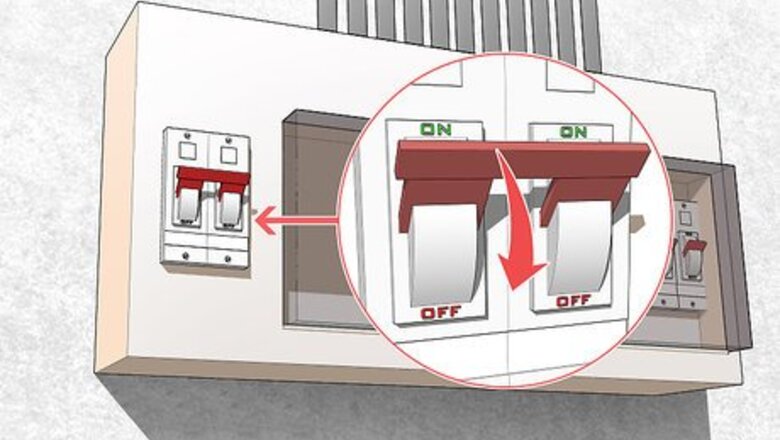
views
Running the Wires
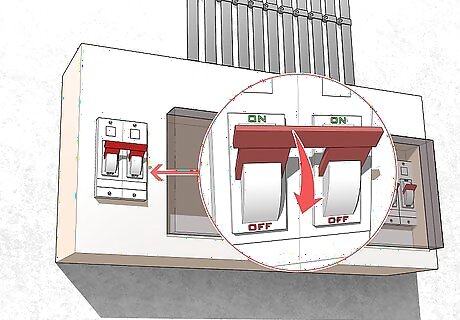
Turn off the main power on your circuit breaker box. Open the door on the circuit breaker box in your home, usually located in a basement, hallway, or kitchen. Look for the breaker switch that controls all the power in your home, which should be alone on either the top or side of the box. Flip the switch to the Off position to cut the power to your home so it’s safe to work on your electrical system. Tape the switch in the Off position so other people know not to turn the switch back on while you’re working. Never work on your electrical system while the power is still on. Doing so could result in serious injury or death. Use a contact voltage tester on the wires inside your circuit breaker box to see if they still have power if you want to double check if they have a current through them.
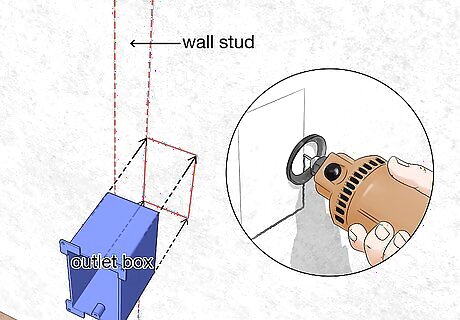
Make a hole in the wall where you plan to install the 220 outlet that matches the size of the outlet box you’re using. Use an outlet box that’s large enough to house the 220 outlet you plan on installing. Find a spot on your wall that’s next to a stud to place the outlet box, and trace the outline of the box on the wall with a pencil. Use a drywall saw to cut through your wall along the outline you drew so that you can set the outlet box inside. You can buy outlet boxes from your local hardware store. Deeper outlet boxes work best since you have to hide multiple wires inside of them. You can also choose to mount the outlet box directly on your wall, which may be easier if you have cement or brick walls.
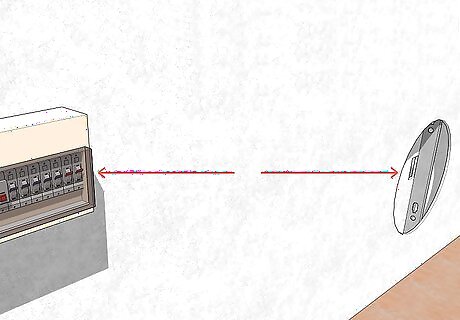
Measure the distance from the circuit breaker box to where you want to place the outlet. Find the shortest route from the hole you cut for the outlet to the main circuit breaker box in your home. You may need to go through the floor or the walls in your home to find the shortest route. Extend a tape measure from the outlet box along the path you chose to the circuit breaker box and record the measurement. If possible, it's usually easier to run the wires vertically through the floor than horizontally through your walls. You may need to take multiple measurements depending on the layout of your home and the obstacles between the outlet and circuit breaker box.
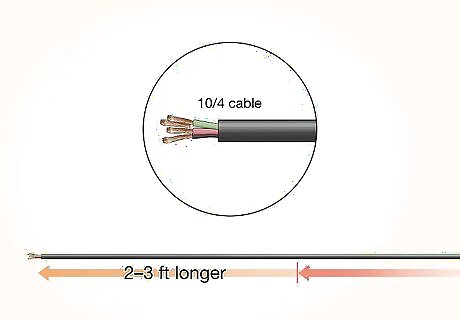
Cut 10/4 cable so it’s 2–3 ft (61–91 cm) longer than your measurement. 10/4 cable has red, black, white, and green wires inside of it. Stretch out the cable so it’s the same length as the measurement you took plus an extra 2–3 feet (61–91 cm) so you can maneuver the wires around. Once you are certain you have the right amount of cable, use a pair of wire cutters to cut through the ends of the cable. You can buy 10/4 cable and wire cutters from your local hardware store. The “10” in 10/4 refers to the wire gauge. You may also use 8-gauge wires if for your 220 outlet if you want.
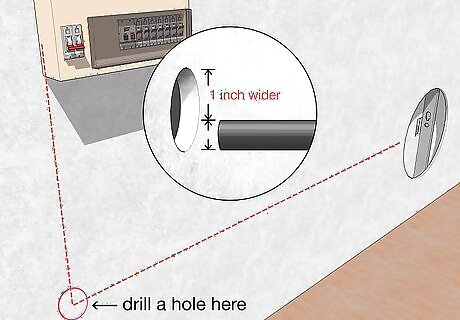
Drill or cut a hole near your circuit breaker box so you can run the cable to it. Find the spot on your ceiling or wall by the circuit breaker box that’s along the path you measured earlier. Use a drywall saw or drill to cut through the wall or ceiling to make a hole that’s 1 inch (2.5 cm) wider than the diameter of the cable. When you’re finished, the cable will run out of the hole and into the circuit breaker box. If you need to cut through concrete or brick, use a drill with a masonry bit so you don’t cause any damage to the tool or chip the wall.
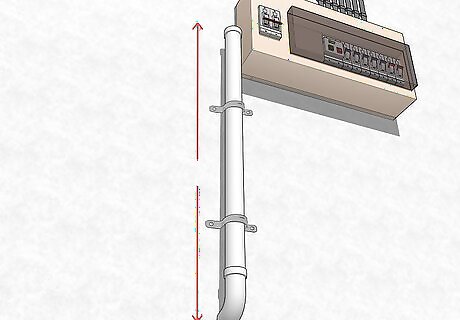
Install electrical conduit between the breaker box and the hole you drilled. Wires for 220 lines cannot be exposed outside of your walls since they could easily get damaged, which could cause serious injury or death. Get enough rigid metal conduit to run from the side of the breaker box to the hole you cut and attach it to your wall using conduit straps every 1–2 feet (30–61 cm). If the 220 line goes through the floor, then you must also install conduit through the floor. You don’t have to run conduit in your walls.
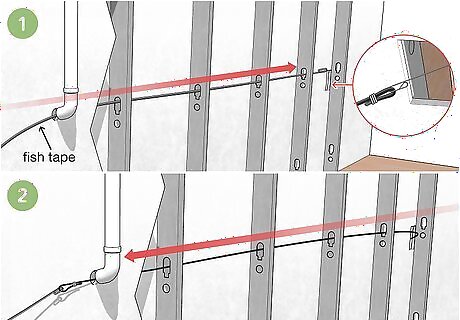
Fish the cable through the walls between the outlet and breaker box. Use a fish tape, which is a long flexible cable with a hook on the end so you can easily pull wires and cables through your wall. Feed the fish tape into the hole near your circuit breaker box and push it through toward the hole you cut for the outlet box. Once the tape reaches the outlet hole, attach the 10/4 cable to the hook on the fish tape. Go back to your circuit breaker box and reel in the fish tape so it pulls the cable with it back through the hole. You can buy fish tape from a hardware store or online. If you don’t want to fish the cable through your walls, you can also attach metal conduits to your wall and feed the cable through it instead. You can buy metal conduits from your local hardware store.Tip: If you need to run the cable through your wall horizontally, then you may need to drill holes through wall studs so you can fit the wire through it.
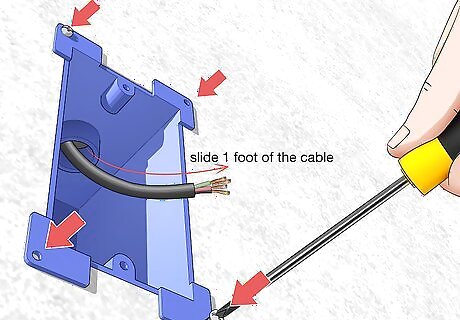
Screw the outlet box into the wall so it stays in place. Slide 1 foot (30 cm) of the 10/4 cable through the hole on the back of the outlet box. Position the outlet box inside of the hole so the front sits flush with the wall, and secure the screw on the side of the box to the wall stud that’s next to it. If you’re attaching the outlet box directly to a concrete or brick wall, be sure to use masonry anchors so the screws don’t slip out of place.
Attaching the Wires to the Outlet
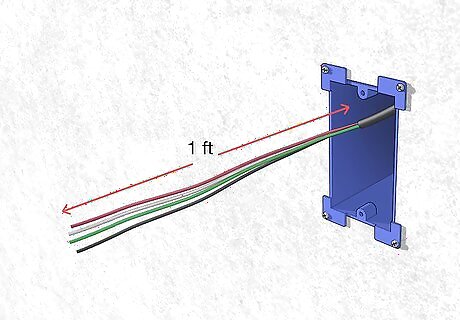
Remove 1 ft (30 cm) of the outer coating of the 10/4 cable. Clamp a wire stripper around the outlet end of the 10/4 cable so it’s 1 foot (30 cm) from the end. Pull the wire stripper toward the end of the cable to cut through the outer coating and expose the wires inside. If the coating doesn’t come off right away, try clamping the stripper around the cable again. If you can’t get a wire stripper to take off the cable’s coating, carefully cut through it with a utility knife and peel the coating back to expose the wires.
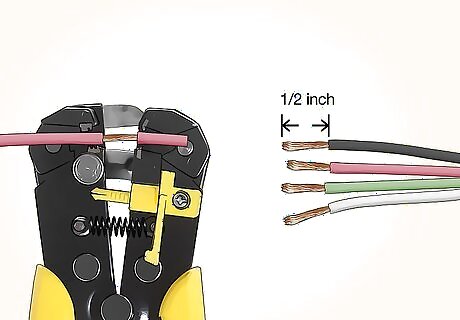
Strip ⁄2 in (1.3 cm) of insulation off the ends of each wire. Work on 1 wire at a time or else you won’t remove the insulation as well. Grip the last ⁄2 inch (1.3 cm) of the wire in the jaws of the wire stripper and squeeze the handles together. Pull the wire stripper toward the end of the wire to cut off the insulation. Repeat the process for the other 3 wires that were inside the cable.
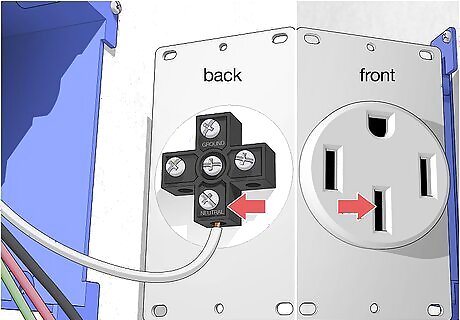
Feed the white wire into the slot with the neutral screw on the outlet. Look on the back of the 220 outlet that you have to find the screw that’s labeled “White” or “Neutral.” Locate the port on the side of the outlet that’s directly under the neutral screw and push the end of the white wire into it. Use a screwdriver to tighten the screw and clamp the white wire in place. Lightly tug the white wire to ensure it doesn’t come loose. Sometimes, the screw on the outlet may be painted white so you can easily see which wire is supposed to go around it.
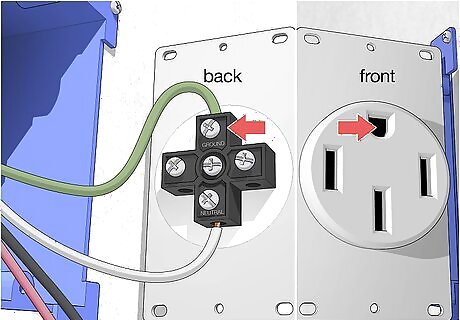
Attach the green wire to the grounding screw on the outlet. Look for the grounding screw labeled “Green” or “Ground” directly across from the neutral screw. Put the green wire into the port next to the grounding screw and tighten it with a screwdriver so it doesn’t move around or fall out. Pull on the green wire to make sure it doesn’t slip out from the outlet. The screw may also be on a metal grounding strap rather that extends out from the back of the outlet.Tip: The ground wire inside the cable may be uninsulated rather than green. Put the uninsulated wire on the grounding screw instead.
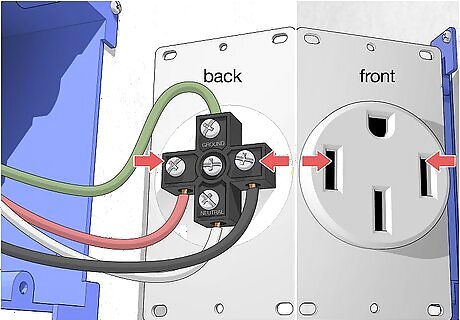
Put the black and red wires into the hot ports on the back of the outlet. There will be 2 unlabeled screws left on the back of the outlet, which are known as the hot screws. Place the end of the black wire in the port next to one of the unlabeled screws, and the red wire in the port on the other. Tighten the screws with a screwdriver to clamp the wires in place so they can’t fall out. It doesn’t matter which unlabeled screw the red or black wire is attached to since they both will carry the same current to the outlet.
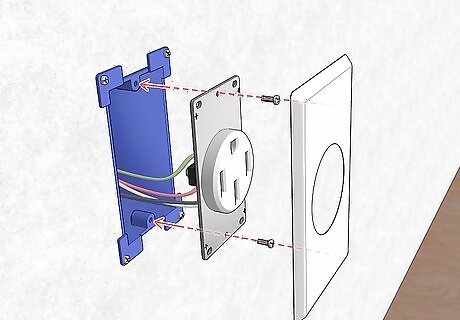
Push the wires and outlet into the box so you can screw it in place. Bend the wires so they can fit in the back of the box. Push the outlet in front of the wires so the screw holes on the outlet line up with the ones along the sides of the box. Use a screwdriver to secure the outlet in place so it doesn’t come free. Screw a wall plate over the outlet to hide the inside of the outlet box and wires. When you need to access the wires, unscrew the wall plate so you can get to them.
Connecting the Breakers to Power
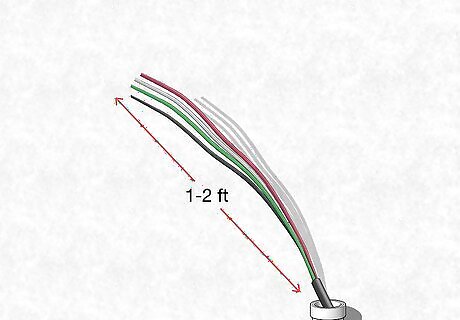
Strip the insulation from the 10/4 cable and the wires that will connect to the circuit breaker. Grip the last 1–2 feet (30–61 cm) of the 10/4 cable between the jaws of a wire stripper and pull them toward the end to cut off the coating. Clamp the stripper ⁄2 inch (1.3 cm) from the ends of each wire from inside the cable and remove the insulation around them. Work on 1 wire at a time so you don’t accidentally damage them. Use a utility knife to cut through the coating on the 10/4 cable if you can’t remove it with your wire strippers.
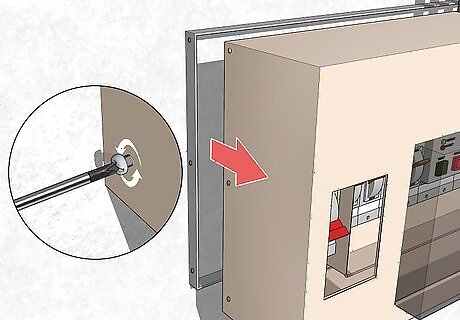
Remove the safety panel from the front of the box. The safety panel on your circuit breaker box is the cover that hides all of the wires and breakers inside. Locate the screws around the edges of the circuit breaker box and rotate them counterclockwise to loosen them from place. Set the panel aside while you’re working so it’s out of the way. Never remove the safety panel cover while the power is still on. This could cause to get electrocuted.
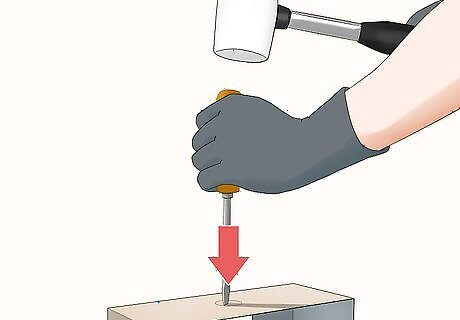
Take out the circular knockout on the side or top of the circuit breaker box. Inspect the sides or top of the circuit breaker box to look for a circular piece that has a precut edge around it, also known as the knockout. Position the end of a screwdriver in the middle of the circle, and tap on the screwdriver’s handle with a hammer to punch the knockout out from the side. You can use a hole in the side of your circuit breaker box that already has wires running through it if there’s room for your cable. You may have to drill through the circuit breaker box if there aren’t any more knockouts you can use. Be sure to use a drill bit meant for metal.
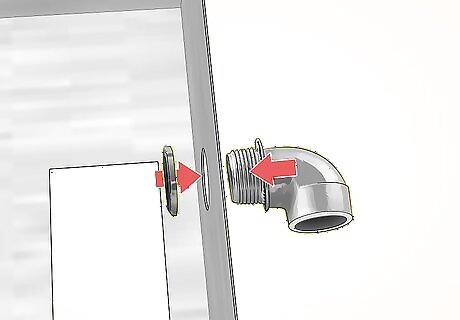
Put a cable clamp in the hole you just knocked out. A cable clamp is a small cylindrical shape with metal bars on top to protect cables and hold them so they don’t slip. Get a cable clamp that matches the size of the knockout on your circuit breaker box, and slide the clamp through the hole. Screw the locking nut onto the threaded end of the clamp to hold it securely against the box. You can buy cable clamps from your local hardware store.
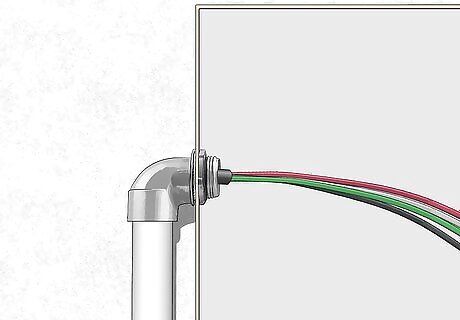
Feed the wires from the cable through the clamp into the box. Push the 4 wires from the 10/4 line between the bars on top of the cable clamp so they go inside the circuit breaker box. Pull the wires into the box completely so you have 1–2 feet (30–61 cm) of wire to work with. Once the wires are inside, tighten the screws on the top bars of the clamp so the wires don’t move around. Don’t feed any part of the 10/4 cable that still has the outer coating since it won’t hold the wires as securely. You can always loosen the clamp if you need to pull more wire into the circuit breaker box if it wasn’t initially long enough.
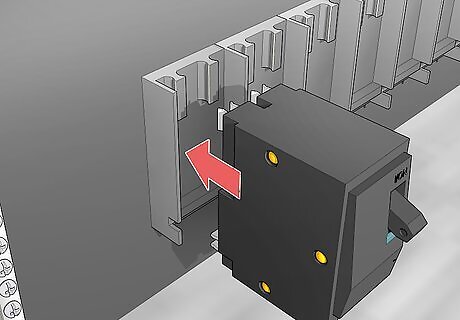
Install a 30-amp double-pole breaker on the circuit. A double-pole breaker allows twice the power to run through it as a standard 15-amp single pole breaker, and takes up the same space as 2 single-pole breakers. Find a spot along the line of other breakers where the double-pole breaker will fit. Push in the top of the breaker into the metal clips inside the box so it snaps into place before pushing the bottom into place. You can buy double-pole breakers from your local hardware store. Make sure you get a breaker that matches the circuit breaker box brand you have. Make sure the breaker is off before you install it. Different brands of breakers snap into place in various ways, so check the instructions before you install it so you don’t accidentally damage them.
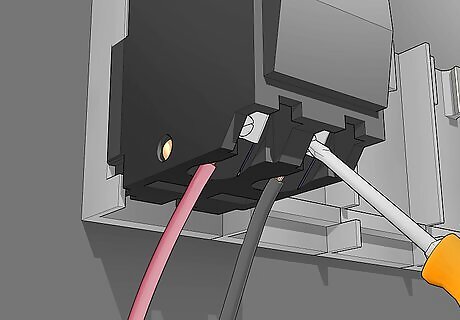
Push the ends of the red and black wires in both ports of the breaker. Once you have it in place, locate the 2 ports in the bottom of the breaker where you’ll connect the power. Take the ends of the black and red wires and feed one of them into each of the ports. Tighten the screws on the bottom of the breaker with a screwdriver to hold the wires in place. It doesn’t matter which ports the black and red wires go into since they’re both transferring power to the outlet.
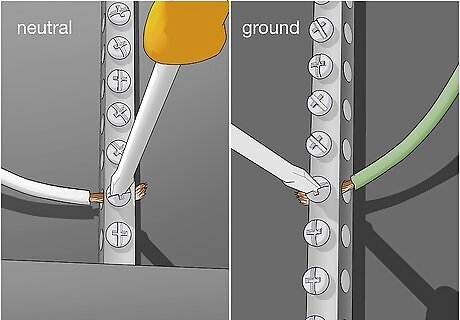
Wrap the green and white wires around the screws on the grounding bar. Look on the inside walls of the circuit breaker box to find a bar with multiple screws and wires attached to it, which is the grounding bar. Bend the ends of the green and white wires into hooks and wrap them around separate screws along the bar. Tighten the screws so the wires don’t move or shift around. Don’t wrap the wires around screws that already have other wires around them since you could short out the power or cause a current to travel to a different appliance.Variation: If there are 2 bars on the walls of your circuit breaker box, one of them will be for neutral wires and the other will be for ground wires. Check the color of the other wires attached to the bars to determine where to place your neutral and ground wires.
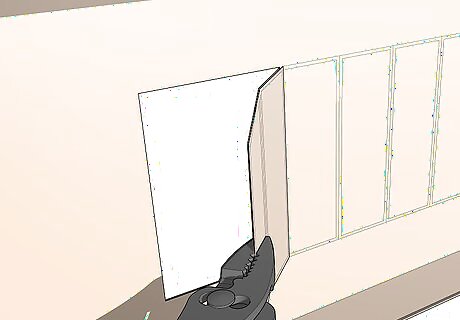
Knock out the slots on the circuit breaker box’s safety cover that line up with the breaker. Hold the safety panel up to the circuit breaker box so you can find where the new breaker lines up with it. Place the end on your screwdriver over the slots where the breaker would go, and tap the end with a hammer to punch it out. Pull off the piece of the safety panel you punched out so the breaker fits easily. You don’t have to punch out any slots if the breaker already lines up with an existing hole in the panel.
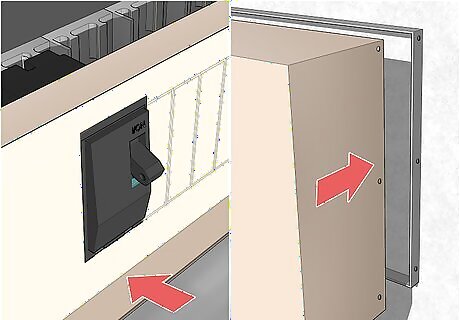
Screw the cover back on the circuit breaker box before turning it on. Hold the panel back up against your circuit breaker box and reattach the screws with a screwdriver. Make sure the safety panel sits tightly on the front of the box and that none of the wires are exposed. Once you finish, turn the main power back on the circuit breaker box so you can use your outlet.




















Comments
0 comment